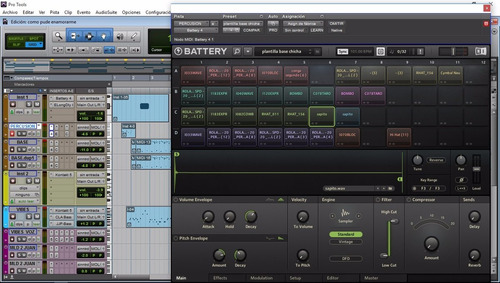

- Native instruments battery 4 review mac os#
- Native instruments battery 4 review manual#
- Native instruments battery 4 review download#
As for the library, Native has adopted the same system as FM7/ 8, Absynth, Guitar Rig, Kore 2 and co., or a system invented by someone else. The general layout has also been revised with the left hand side gaining some space by regrouping the Library, Files and Automation tabs. The disappearance of the general Solo and Mute buttons poses no problem, since clicking on the top of the column or lane selects all the included Cells. Another improvement is the drag and drop feature that covers almost everything: moving a Cell, assigning Cell output to one of the 4 Buss or to Master, etc. Its only because the colors can be found again in the editor (we’ll see that later) that we’re not totally lost within color codes (which are used to identify sample families, for example all kicks). Say hello to the new dominate grey and fluorescent colors for the Cell transparencies and outlines, which is not necessarily a whole lot better: it’s sometimes hard to differentiate between the red, orange or the pink. Gone is the military green interface with the pink, blue and turquoise sections. The first thing that surprises you is the total graphic interface redo. Battery 3 is missing, so here are some of the changes from version 2 (without including the ones we’ve already mentioned, and including 3.1, 3.2, etc.): audio engine updated, resizable matrix, new editor, multi-effects, one time-stretch per pad (also called a Cell), new formats manager (Apple Loops and Acid), mode Drum within the Saturator, new convolution reverb, color coded cells, 64 bits, etc. We’re not going to redo a complete Battery test, since you can read the first version and the second version on Audiofanzine. It’s also a means of production standardization, if you follow name fields to the letter. The classification is very well done and saves a lot of time especially when you’re looking for a precise sound for a precise type of music.

A new scan (Rescan in Preferences>Library) solved the problem.
Native instruments battery 4 review manual#
The manual concerning kit classification as regards to style, (Battery 4 Library Manual English.pdf), wasn’t immediately recognized since it is installed with the Library folder which is installed separately and placed wherever the user wishes. The installation includes the application, the plugs, the O&M Manuals, the Kits and samples. Don’t forget that Native has been using its own data compression algorithm for quite some time, allowing for file size reduction without sacrificing quality. We’ve come a long way since their first version with its 600mg but not quite the 12Gb from version 3.
Native instruments battery 4 review download#
You can download it directly from their site via a compressed 3Gb package which, once installed, will take up 4Gb of space on your hard disk.
Native instruments battery 4 review mac os#
The software is sold for 199 euros (update, 99 euros), and is compatible with Mac and PC, Windows 7 and Mac OS 10.7, and available as a standalone or plug-in (including AAX native, but not, as of yet, RTAS). Native did, however, in the interim, introduce Maschine, and several other virtual drum solutions. We had to wait seven years for a new version to become available as a package with Komplete 9 (basic version and Ultimate) and as a standalone. Updates followed: Battery 2, in 2004 (72 pads, 256 stereo voices, 32 bits audio engine, new formats manager, 3,5 Gb library, etc.), then Battery 3 in 2006 (128 pads, over 12 Gb of samples, over 100 kits, new effects, etc.). The software was compatible with Mac and PC, as a stand alone and a VST plug-in (VST2, DXi, Mas) and could import several different resolutions and formats (Wave and Aiff 8, 16, 24 and 32 bits in LM4 format, Akai S1000 and S3000, SoundFont, LoopAZoid and Reaktor). The first version of Battery had 54 pads, 128 voices (stereo or mono), several output configurations, an interface something like that of LoopAZoid but more intuitive, numerous possibilities for resynthesizing as well as over 600Mb of ready to use samples and kits. The NeXoft team then went to work with Native developers to put together a more powerful tool, dedicated to importing and editing percussion and drum sounds, for a fee. In 2001, Native Instruments introduced Battery to the market, a percussion sampler following in the footsteps of LoopAZoid, software created by NeXoft, which offered 48 tracks, 64 voices, 8 outs and other very appreciated functions, not the least one being the fact that it was free.


 0 kommentar(er)
0 kommentar(er)
